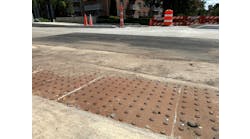Forty years ago, the planning fate of potential construction projects hinged on carbon monoxide levels and impacts to air quality. The technological changes in fuel and the vehicle fleet have reduced this risk factor for transportation project approval.
Today, carbon dioxide (CO2) is a primary greenhouse-gas emission from the transportation system. It threatens project development and construction due to constant scrutiny and discussion about climate change.
As was the case 40 years ago, significant technological advances are in development in terms of fuels and vehicle fleets (such as hybrid, hydrogen and electric vehicles). These advances have great potential to reduce transportation-related greenhouse-gas impacts. Even so, policy to reduce vehicle-miles traveled (VMT) and transportation improvements is an everyday issue in the transportation industry.
Unfortunately, there are few analysis tools or approved methodologies available for the industry to critically compare CO2 emissions and the effects of technology and system performance for project-level studies. Without accepted tools of this like, speculation about impacts regarding greenhouse gases (GHG) expands without critical analysis, leading to a growing sentiment that all transportation projects that add roadway capacity negatively impact climate change.
Nice MOVES, but more needed
To answer the call for quantitative analysis of greenhouse-gas emissions on transportation projects, many jurisdictions (e.g., California’s CAL3HQ tool) and transportation analysis software vendors have created tools that apply measures of vehicle usage to emissions rate tables to estimate greenhouse gases. While these tools continue to develop and become more robust and accessible every year, they have not been nationally accepted as a recommended standard practice. To address this need, the Environmental Protection Agency (EPA) has developed MOVES (Motor Vehicle Emission Simulator) as a tool for regional air-quality analysis. The simulator generates emissions rate tables (considering vehicle types, geography, weather, etc.) that can be applied to aggregate groupings of vehicle speeds.
While the MOVES tool represents a significant advancement in standardizing greenhouse-gas emissions analysis for transportation projects, it is focused on regional analysis for state or metropolitan planning organization (MPO) air-quality compliance. However, today the most common questions are: “Will this highway improvement or operational enhancement increase CO2 emissions?” or “Would an increase in electric-vehicle ownership change our findings?” MOVES has the functionality for greenhouse-gas analysis, but the complexity and understanding of the data inputs, as well as the amount of data and effort required to calibrate the tool to local conditions, may be beyond the means of a typical transportation planning project.
So the question remains, Is there a tool that can answer these questions and is properly scaled to range of analysis from concept development to alternatives evaluation—prior to regional analysis?
Advancing transportation projects from concept to construction requires a wide range of traffic analysis tools and methods from sketch-level planning to detailed design and operation. At each step of the process, traffic data increases in the level of detail, from corridor-level daily traffic volumes to sketch-level intersection capacity analysis to detailed microsimulation of vehicle queues and stops/starts. The transportation performance tools exist that can feed a more localized comparison of GHG, but the link between the two has not emerged.
To demonstrate the issue in an actual transportation project, consider a case study from Portland, Ore., evaluating potential corridors for an improved highway network.
Sketching it out
DKS Associates participated in a recently completed study in the southwest region of the Portland metropolitan area. Metro (the MPO for the Portland region), the Oregon Department of Transportation (ODOT) and Washington County led a corridor study to identify potential east-west corridor improvements to better connect I-5 to Highway 99W. The scale of the study was somewhere between a regional framework plan and a detailed corridor evaluation. Essentially, it was a subarea transportation system plan that required evaluation of a broad set of alternatives to ultimately decide if and where to invest hundreds of millions in capital improvements. As the corridor study was not a regional level air-quality assessment, the partner agencies and project team struggled with how to appropriately integrate GHG estimates as a performance measure for alternatives comparison.
Given the lack of an agency-approved method for evaluating GHG on a corridor project, let alone a lack of a lithe, sketch-level planning tool that could balance the needs for defensible analysis with the project resources, the project team was faced with the issue of how to best tackle air-quality evaluation early in a project development process.
As a result, the project team looked for a sketch-level method to utilize the transportation tools and information that were already developed for the project. The subarea model developed for the study provided robust macroscopic travel speed data along corridors in the study area. To relate these corridor speeds to GHG emissions, we turned to research that provides rates of CO2 emissions by average motor vehicle speeds.
Our project team found that research published by Matthew Barth and Kanok Boriboonsomsin at the University of California-Riverside provides one of the most readily understandable relationships between vehicle speed and CO2 emission. The general emission rates can be easily applied to average vehicle speeds to estimate CO2 emissions outside of utilizing software packages such as MOVES.
Using CO2 emissions rates to determine an aggregate estimate of total peak-period CO2 emission output in the study area, a sketch-planning tool was developed to compare GHG for numerous alternatives. It is acknowledged that the actual emissions estimates might not be accurate, considering the lack of local calibration of the emissions rates, but this rapid-to-use tool provided a useful comparison measure.
Some interesting findings emerged. While reducing system-wide delay by up to 45% and key corridor travel times by 30%, CO2 emissions might increase due to latent demand utilizing the enhanced roadway network and increasing the amount of vehicle travel. How could this be? The congested corridors would have improved travel speeds, less stops/starts, but increased GHG emissions? We finished the sketch-level analysis with more questions than answers. The project stakeholders were not completely satisfied. Ultimately, the project team had not eliminated the risk of climate-change speculation in the alternative-selection process.
Surrounded by models
The sketch-level methods used to evaluate CO2 emissions between transportation alternatives seemed to be a reasonable approach to rapidly and cost-effectively compare alternatives. However, the results of the analysis led us to wonder if such a sketch-level approach was accurate enough to say which alternatives performed better than others. Did the travel-speed profiles predicted by our subarea travel demand model match the underlying start/stop activity in the emission rate estimate data set? Furthermore, should there be a range of emission rate data provided from tailpipe research that match the level of complexity of the estimated traffic data?
Consider the range of tools that are used in the transportation-planning process to determine vehicle speeds. Regional travel demand models (e.g., EMME, Cube, TransCAD or VISUM) generate macroscopic travel-speed profiles that may vary little along a corridor. A refined subarea model may introduce greater network detail to improve the resolution of the vehicle-speed profiles between intersections, but the delay caused by actual intersection operations are still generally ignored.
A mesoscopic model, which blends a travel-demand model network with some basic intersection operations, might accurately reflect average travel speeds going up and down between intersections on a corridor, but it likely still fails to capture the complex queuing behavior that occurs in a congested network. A detailed operations model (e.g., Synchro) or a microsimulation model (e.g., VISSIM or Paramics) can be developed to capture queue lengths and the number of starts and stops. Each of these tools has a well-defined place in the scale, level of detail and level of effort required for decision making in traditional transportation planning processes. However, each tool provides a different level of detail about actual vehicle operations along a corridor, so how can one set of emission rates be applied to each application?
Changing with the climate
Further research and collaboration between transportation experts and air-quality experts is needed to explore how GHG emissions estimates can be folded into the transportation project planning and analysis process. Data-intensive tools such as MOVES may be leading the industry toward a defensible technical finding, but there is a need to further enhance the variables of the tools and find a way to integrate them into the software packages that are commonly used for transportation studies at less cost and reasonable accuracy for comparisons. Specifically, we recommend additional research to accomplish these objectives, such as:
Providing options for testing changes in vehicle fleets. Is the percent of pre-1990 vehicles vs. post-1990 vehicles in the fleet a significant factor? Is the performance of various passenger-car classes (e.g., economy, compact, standard and full-size) and their portion of the vehicle fleet significant? For each vehicle type, how does the introduction of hybrid, electric or alternative-fuel technology modify the emission-rate profile?;
Providing readily available look-up tables for emissions (possibly by vehicle type, age and fuel source) that match the level of start/stop data resolution provided by transportation tools ranging from travel demand models to mesoscopic models to microsimulations. Work with software vendors, as needed, to import these emission-rate tables into their platform to allow rapid analysis of multiple scenarios in the traffic analysis environment; and
Providing formal guidance on what tools and techniques are appropriate for various levels of studies so that state DOTs and local agencies can adopt methodology standards in order to provide consistent and defensible information for decision making—not only for regional plans but for project-level plans and operational enhancements (such as signal timing).


